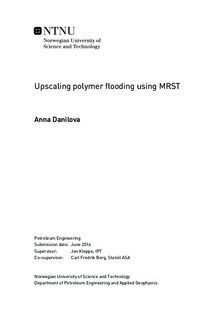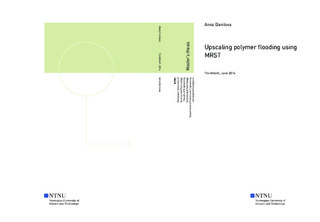| dc.description.abstract | Reservoir simulation models are widely used as a decision making tool in oil and gas industry. Modern technologies allow creating very detailed high-resolution models to represent the properties of a reservoir system as accurately as possible. However, such models become computationally heavy, which complicates field development studies, history matching and other procedures that require testing a large number of possible scenarios.
Upscaling is the common solution that aims to find a balance between the simplification of the model and keeping the accuracy of the simulation results. Extensive research has been devoted to this topic, and a number of methods for single-phase and two-phase flow upscaling have been developed. However, much less attention has been paid to the upscaling of the Enhanced Oil Recovery (EOR) methods. The goal of this thesis was to investigate various upscaling methods of polymer flooding.
In this study, polymer flooding is upscaled with the assumption of steady-state flow. For simplicity, we assume that reduction factor, residual resistance factor and inaccessible pore volume are constant. Then the only polymer related parameter to be upscaled is polymer adsorption, which is in the focus of this thesis. In order to test polymer flooding upscaling in a highly heterogeneous medium, the SPE10 comparative model has been chosen as the fine-scale model. Several polymer adsorption upscaling methods, including a newly developed method based on the fraction of fluid flow in different grid cells, were investigated. Results of polymer flooding simulation with upscaled parameters in coarse models were compared to results in the original fine-scale model. Areal and vertical sweep, zones of intensive adsorption, polymer adsorption behavior through time and production data on coarse and fine scales were analyzed to evaluate the most efficient and accurate methods. Polymer adsorption analysis has been performed for models of different dimensions and complexity to identify the main factors influencing the coarse-scale solution.
Simple volumetric averaging was found the most accurate method in case when all grid cells have the same polymer concentration, but if some areas of reservoir are bypassed, this method overestimates coarse-scale polymer adsorption due to the influence of low-permeability zones. The use of polymer adsorption function on coarse scale accounts for fine-scale flow patterns better and gives more accurate polymer adsorption estimation than volumetric averaging in case when not all zones of reservoir are involved in the fluids flow. The newly developed flow fraction coefficient formula was found to give the most precise estimation of coarse-scale polymer adsorption in synthetic models, but it needs further improvements to take into account the full flow through a coarse cell in the realistic models. | |

